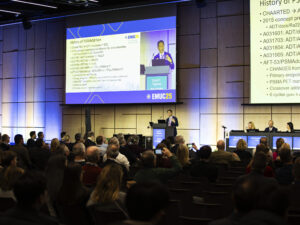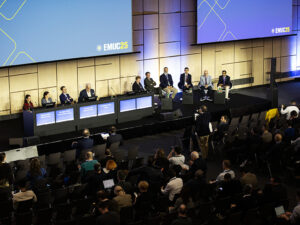In his EMUC25 lecture ‘ctDNA in muscle-invasive bladder cancer: Ready for prime time?’ Prof. Lars Dyrskjøt (DK) shared data to back up his expert opinion on the use of ctDNA. “ctDNA analysis can guide adjuvant treatment after cystectomy. You can safely omit adjuvant immunotherapy in ctDNA-negative patients (95% 1-year recurrence free survival [RFS] in IMvigor011 trial, 97% 1-year RFS in TOMBOLA trial.)”
For ctDNA-positive patients, adjuvant immunotherapy can be offered, with demonstrated treatment efficacy in a predominantly clinically high-risk population (IMvigor011), and a 50% ctDNA clearance in both low- and high-risk groups (TOMBOLA).
Prof. Dyrskjøt: “Overall, ctDNA-based molecular stratification outperforms clinical and histopathological risk assessment in identifying patients who benefit from adjuvant treatment, as shown in both IMvigor011 and TOMBOLA.”
In regard to the requirements for implementing ctDNA-guided care, Prof. Dyrskjøt stated that “Sensitive tumour-informed tests are required. Continued ctDNA analysis is needed, a single test post-RC is not enough, and assay availability and fast turnabout time are essential. We need to generate knowledge on how to bridge and use ctDNA in the peri-operative setting (NIAGARA, KEYNOTE-905/EV303, etc.).”
On his overall view on ctDNA use, he concluded, “Yes, it can be used for guiding adjuvant immunotherapy. But for guiding pre-cystectomy treatment – no, not yet; we need more studies first.”
Following this was a presentation on ‘Treating metastatic bladder cancer when money is an issue’, by Dr. Jorge Estaban Villarrubia (ES). “Back in October 2023, we were all excited about the enfortumab -vedotin + prembrolizunam (EV-P) data presented, and then the 2024 guidelines were updated and the EMA granted approval for the new combination.”
But according to Dr. Estaban Villarrubia, it is important to note that although the survival rates of this combination therapy are impressive, its high-cost limits broader use in many public health settings. In addition, some countries (including Spain) are still awaiting approval of EV-P, and there is also the issue of access to NGS (next-generation sequencing) which is not readily available in all hospitals.
“As oncologists, we must ask some important questions when we can’t get the best systemic therapy. What are the next best options for maximising treatment benefit, without increasing toxicity? Is there a role for radical treatment options?”
He reviewed treatments such as chemotherapy (cisplatin), split dose cisplatin for cisplatin-ineligible symptomatic patients, as well as strategies supported by evidence to reduce the number of cycles in order to minimise toxicity.
In his take-home messages, he concluded, “When money is an issue, we still have therapeutic options with proven efficacy. Collaboration between institutions is key to providing access to precision medicine, clinical trials and best available care. Multidisciplinary management of the patient leads to better outcomes, not only in survival, but quality of life, too. We must not forget that palliation is an important target of our treatment.”
For more information, you can (re)watch the presentations via the EMUC25 Resource Centre.





